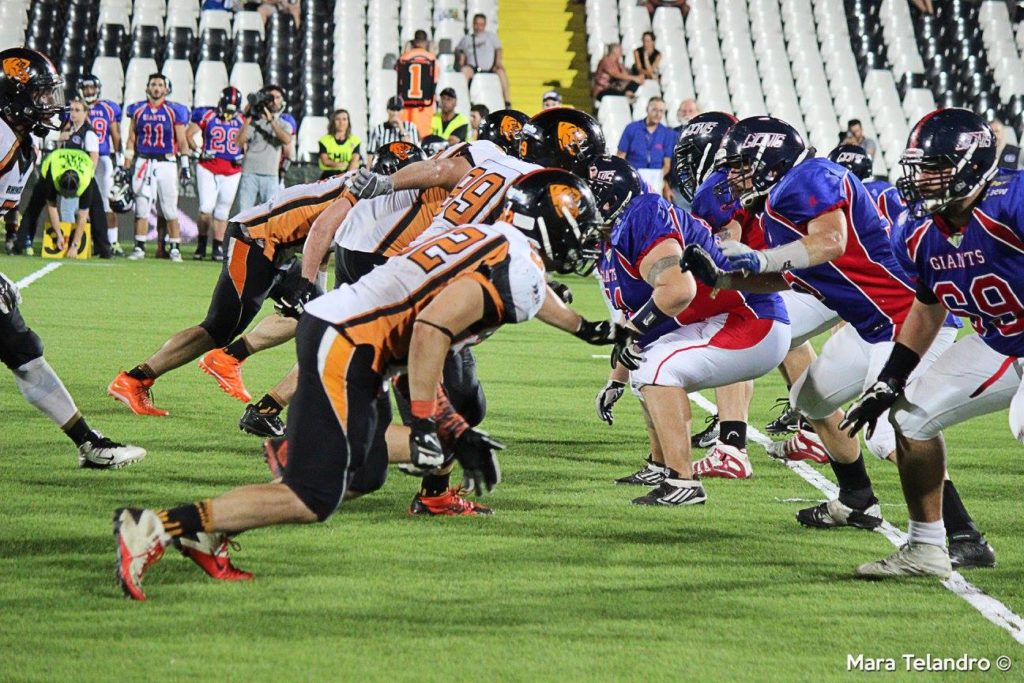American Football International contributor Aarnout Ecker, a Belgian coaching in Italy for the 2016 Italian champion Milano Rhinos, takes an in-depth look at some of the offenses he faced off against this season in Italy’s top American football league, the Italian Football League (IFL).
This week we look at the Rhinos Italian Bowl XXXII opponents, the Bolzano Giants.
The past year I had the amazing privilege of moving to Italy and getting to coach for the Milano Rhinos in Italy’s 1st division (IFL) under legendary head coach Chris Ault.
Il Giorno Newspaper Monday July 11, 2016 after the Rhinos victory in the Italian Superbowl
What started out as an exciting adventure full of unknowns quickly turned into a challenging but immensely rewarding journey in which the Rhinos defense managed to keep every offense it faced — sometimes easily, other times just barely — in check to walk away victoriously.
This post and the following ones not only serve as an introduction for others to American football in Italy, but also aim to serve as thank you notes to all the opposing offensive coaches and players in the IFL who prodded, stung and sometimes badly wounded our defense’s integrity. The challenge they posed week in and week out helped me grow tremendously as a coach.
In the following paragraphs, I will limit myself to giving a short overview of the offense utilized by the Giants from Bolzano as they had the special distinction of being the first team we met this season and also the last during the Italian Superbowl.
Other teams the Rhinos faced this year will be the subject of later posts.
Bolzano Giants — Personnel
Just like for every other team in the IFL, the American import players of the Giants — each team is allowed to field 1 American import player on offense and 1 on defense, and additionally an American with an Italian passport can be on the field at the same time as one of the other Americans — had a large impact on the offense’s style.
#12 James Peterson of the Bolzano Giants in action
#12 James Peterson, the Giants’ QB, had a strong arm and loved to run over defenders when he kept the ball. Most importantly though, he never gave up on a play and channeled his inner Brett Favre to make risky, but very often successful, plays.
The Giants’ double passport player #11, Garret Sanvido, not only served as a running back but also lined up in the slot as a receiver running short routes or to catch screen passes.
As for the Italian players on the team, special mention has to be made of the duo of receivers Bonacci (#9) and Podavitte (#19). Whereas Bonacci stretched the defensive coverage on deep routes and comebacks, Podavitte forced the linebackers to hustle when running in-breaking routes at various depths as a slot receiver.
Generally speaking, the Giants preferred to have 20 personnel (two running backs and three receivers) on the field with which they would line up in a diverse set of formations.
Bolzano Giants — Formations
Doubles formation
The Giants’ most used alignment was a shotgun (running back offset) or pistol (running back behind the QB) doubles (two receivers to each side) formation.
Giants Doubles formation
With this formation the Giants force a defense with four down linemen like the Rhinos to make a difficult choice:
- Keep two linebackers in the box against the running game, thus forcing a 2 on 2 situation in the passing game on the weak side; or
- Widen out the weak side linebacker, thus being weaker against the running game, but retain the ability to reroute the slot receiver and play with a safety over the top.
Run n’ Shoot
The second favorite alignment of the Giants was the old Run n’ Shoot or Georgia Southern double wing formation. The wings would usually be a running back such as #99 Palini or #11 Sanvido and a slot receiver like #19 Podavitte.
Giants Run n’ Shoot formation
From this alignment, either with the QB under center or in the pistol, the offense could threaten defenses in multiple ways:
- Four receivers going deep;
- ISO/lead play with one of wings serving as the lead blocker inside;
- Outside running plays with one of the wings leading outside or blocking in on the outside linebacker;
- Crossing routes over the middle by the wings.
Trips Formation
When the Giants were in a passing situation they liked to line up in a trips formation.
Giants Trips Formation
This formation, especially in the red zone (generally defined as 20 yards or less from the opponent’s end-zone) forces the defense to widen out a linebacker on the number three receiver with the risk of allowing Peterson to run wild with the running back leading up the middle or on option plays.
Two Back Formations
If the Bolzanini wanted to run the ball or make their play action game more credible they would line up with two running backs in the backfield. They were very multiple with their alignment of these two backs and the QB as they lined up in (offset) I formations with the QB in the pistol or under center or, alternatively, with split backs from under center or with the QB in the shotgun.
Giants Two Back formations
Empty Formations
Finally, and most notably so during the Italian Superbowl, the Giants lined up in 3×2 or 4×1 empty formations with the QB in the shotgun.
What they did from this empty set and more detailed descriptions of the Giants’ favorite plays in all other formations will be the subject of my next post, so stay tuned…

